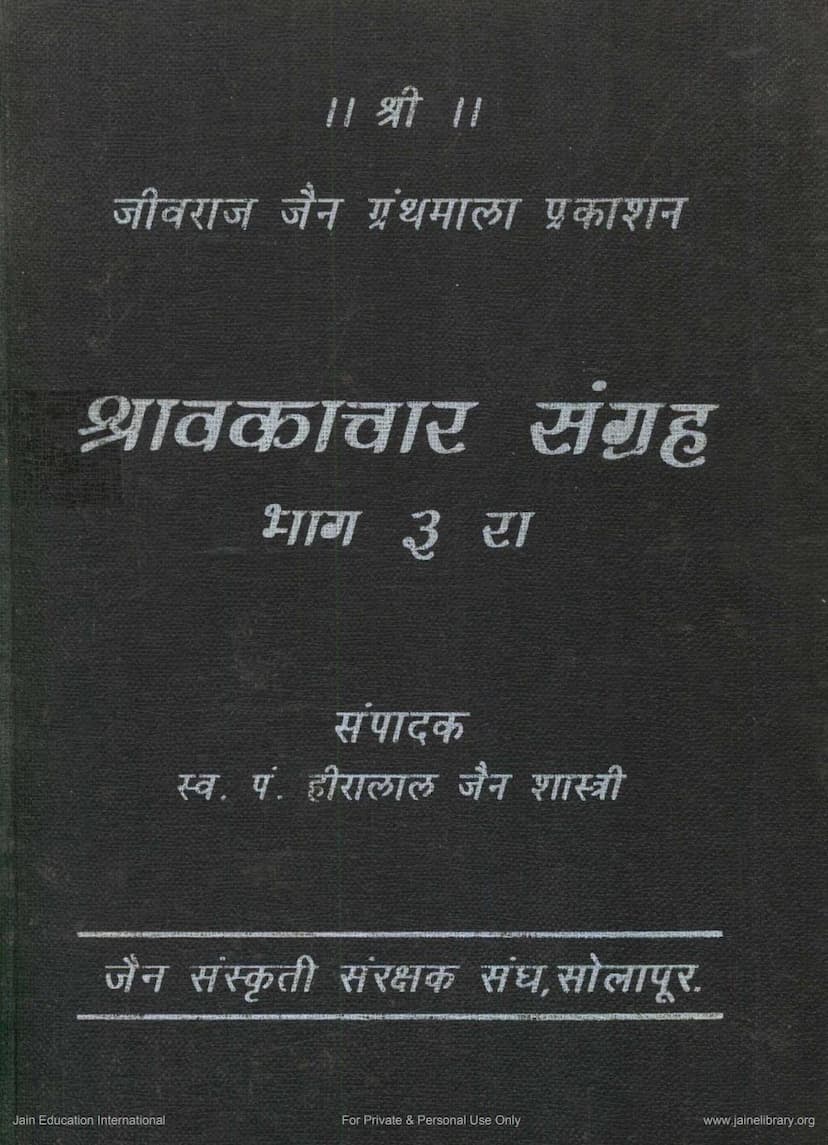Sharavkachar Sangraha Part 3
Added to library: September 2, 2025

Summary
Based on the provided Jain text, "Sharavkachar Sangraha Part 3," compiled and translated by the late Pandit Hiralal Jain Shastri, and published by Jain Sanskriti Samrakshak Sangh Solapur, here's a comprehensive summary in English:
Book Title: Sharavkachar Sangraha Part 3 (Collection of Lay Follower Conduct Texts, Part 3) Author/Editor: Late Pandit Hiralal Jain Shastri Publisher: Jain Sanskriti Samrakshak Sangh, Solapur Series: Jivraj Jain Granthamala, Solapur (Hindi Section Pushpa 29) Content: This volume is the third part of a compilation of nineteen texts (Sharavakas) detailing the conduct and principles for Jain lay followers (Shravakas). It specifically includes the "Latimata" and eleven other sections describing lay follower dharma from various texts.
Core Purpose and Content:
- Guidance for Lay Followers: The primary aim of the "Sharavkachar Sangraha" series, and this volume in particular, is to provide comprehensive guidance on the ethical and spiritual conduct expected of Jain lay followers (Shravakas). It elaborates on the principles of Jainism as they apply to householders.
- Upaasaka Adhyayana: This volume is presented as a unique and valuable work illuminating the "Charanaanu yoga" (conduct-based spiritual path) within the "Upaasaka Adhyayana" (study of lay followers).
- Daily Life and Spiritual Practice: The texts detail the nature of lay follower dharma, the daily routine of those devoted to spiritual practice, and the sequential observance of vows and restraints necessary for the purification of consciousness (parinama).
- Compilation of Diverse Texts: This third part compiles "Latimata" and other relevant portions from eleven different Jain texts that discuss the duties and practices of lay followers, presenting them in a collected format. Some initial parts considered unnecessary for inclusion were omitted, like the introductory sections of "Latimata."
Key Themes and Features Highlighted (from the Editorials and Preface):
- Importance of Samyakdarshan: The collection emphasizes the foundational role of Samyakdarshan (Right Faith) in the complete practice of lay follower dharma.
- Detailed Analysis of Texts: The editorial section (Pradhan Sampadakiy) of the series, and likely the intention for this volume, is to provide comparative studies of various Sharavakas, highlighting their unique contributions, chronological context, and doctrinal nuances.
- Specific Textual Features: The editorial mentions specific unique aspects of certain texts within the collection:
- Ratnakaranda Shravakachara: Noteworthy for its extensive forty verses on the glory of Samyakdarshan at the beginning. a Purusharthasiddhi Upaya: Its unique beginning discussing Nischaya (Absolute) and Vyavahara (Conventional) truth, with Vyavahara being termed 'abhootartha' (not the ultimate truth). It also discusses how even a partial practice of the Three Jewels (Ratnatraya) is a means to liberation, not bondage.
- Discussion on Punhya (Merit): The compilation includes discussions on the nature of Punhya, its relation to auspicious consciousness (shubha upyoga), and how it can be a cause of progress towards liberation, especially when it is non-discriminatory and free from fixation.
- Inclusion of Previously Published Works: The introduction notes that most of the Sharavakas included in the collected volumes had been previously published, but their compilation in this manner is innovative and highly valuable for scholars and serious seekers.
- Endowment and Legacy: The introduction mentions the significant contribution of Shri Brahmachari Jivraj Gautamchand Doshi of Solapur, who, being detached from worldly life, dedicated his earnings and later his entire fortune (approximately two lakhs) to the Jain Sanskriti Samrakshak Sangh for the preservation, propagation, and publication of Jain culture and literature. The Jivraj Jain Granthamala has published numerous works in Hindi, Marathi, and other sections.
- Editor's Dedication: The preface expresses gratitude to the late Dr. A. N. Upadhye, who provided the initial inspiration for this compilation by sending a list of Sharavaka texts. It also acknowledges the editing and Hindi translation work done by the late Pandit Hiralalji Shastri, recognizing his profound understanding of Jain principles.
- Future Volumes: The editorial indicates that a detailed introduction, covering the chronological introduction of Sharavaka authors, the special features of each text, the development of virtues and vows, details on puja methods, meditation, vows, and discussions on concepts like Nidana (desire for worldly benefits), was planned for this third volume but could not be included due to its extensive size. Readers are invited to wait for the fourth volume for this detailed introduction.
- Correction Sheet: A correction sheet for all three volumes is included due to minor errors.
Overall Significance:
"Sharavkachar Sangraha Part 3" is a significant contribution to Jain literature, offering a consolidated and accessible resource on the practical and ethical guidelines for lay followers. It reflects the depth and richness of Jain tradition in guiding individuals towards spiritual progress within their worldly lives. The work is a testament to the dedication of scholars like Pandit Hiralalji Shastri and philanthropic efforts like that of Brahmachari Jivraj Gautamchand Doshi in preserving and propagating Jain teachings.